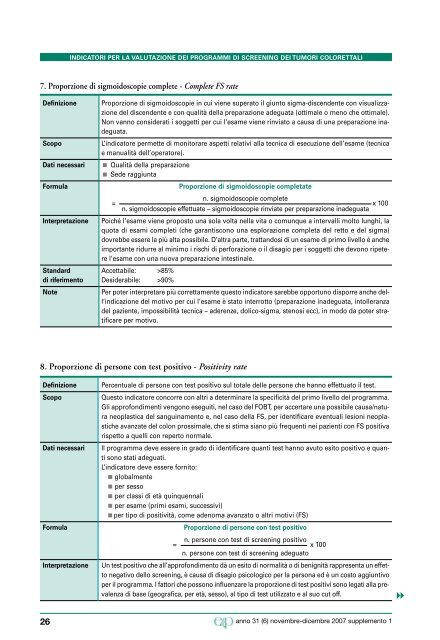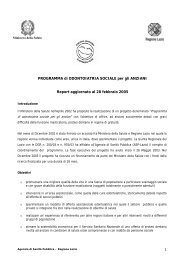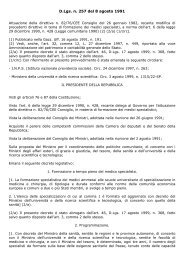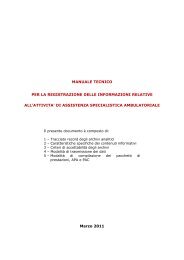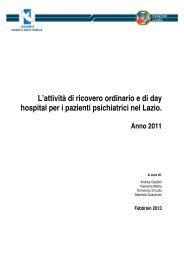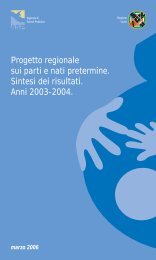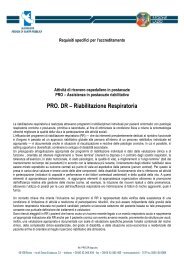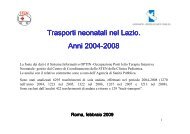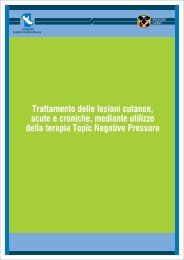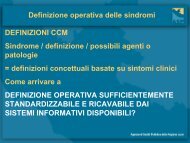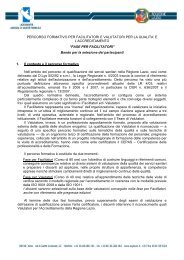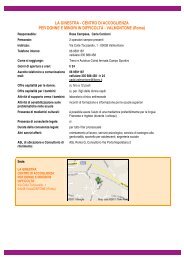Indicatori di qualità per la valutazione dei programmi di screening ...
Indicatori di qualità per la valutazione dei programmi di screening ...
Indicatori di qualità per la valutazione dei programmi di screening ...
You also want an ePaper? Increase the reach of your titles
YUMPU automatically turns print PDFs into web optimized ePapers that Google loves.
7. Proporzione <strong>di</strong> sigmoidoscopie complete - Complete FS rate<br />
Definizione Proporzione <strong>di</strong> sigmoidoscopie in cui viene su<strong>per</strong>ato il giunto sigma-<strong>di</strong>scendente con visualizzazione<br />
del <strong>di</strong>scendente e con <strong>qualità</strong> del<strong>la</strong> preparazione adeguata (ottimale o meno che ottimale).<br />
Non vanno considerati i soggetti <strong>per</strong> cui l’esame viene rinviato a causa <strong>di</strong> una preparazione inadeguata.<br />
Scopo L’in<strong>di</strong>catore <strong>per</strong>mette <strong>di</strong> monitorare aspetti re<strong>la</strong>tivi al<strong>la</strong> tecnica <strong>di</strong> esecuzione dell’esame (tecnica<br />
e manualità dell’o<strong>per</strong>atore).<br />
Dati necessari Qualità del<strong>la</strong> preparazione<br />
Sede raggiunta<br />
Formu<strong>la</strong> Proporzione <strong>di</strong> sigmoidoscopie completate<br />
n. sigmoidoscopie complete<br />
= x 100<br />
n. sigmoidoscopie effettuate – sigmoidoscopie rinviate <strong>per</strong> preparazione inadeguata<br />
Interpretazione Poiché l’esame viene proposto una so<strong>la</strong> volta nel<strong>la</strong> vita o comunque a intervalli molto lunghi, <strong>la</strong><br />
quota <strong>di</strong> esami completi (che garantiscono una esplorazione completa del retto e del sigma)<br />
dovrebbe essere <strong>la</strong> più alta possibile. D’altra parte, trattandosi <strong>di</strong> un esame <strong>di</strong> primo livello è anche<br />
importante ridurre al minimo i rischi <strong>di</strong> <strong>per</strong>forazione o il <strong>di</strong>sagio <strong>per</strong> i soggetti che devono ripetere<br />
l’esame con una nuova preparazione intestinale.<br />
Standard Accettabile: >85%<br />
<strong>di</strong> riferimento Desiderabile: >90%<br />
Note Per poter interpretare più correttamente questo in<strong>di</strong>catore sarebbe opportuno <strong>di</strong>sporre anche dell’in<strong>di</strong>cazione<br />
del motivo <strong>per</strong> cui l’esame è stato interrotto (preparazione inadeguata, intolleranza<br />
del paziente, impossibilità tecnica – aderenze, dolico-sigma, stenosi ecc), in modo da poter stratificare<br />
<strong>per</strong> motivo.<br />
8. Proporzione <strong>di</strong> <strong>per</strong>sone con test positivo - Positivity rate<br />
Definizione Percentuale <strong>di</strong> <strong>per</strong>sone con test positivo sul totale delle <strong>per</strong>sone che hanno effettuato il test.<br />
Scopo Questo in<strong>di</strong>catore concorre con altri a determinare <strong>la</strong> specificità del primo livello del programma.<br />
Gli approfon<strong>di</strong>menti vengono eseguiti, nel caso del FOBT, <strong>per</strong> accertare una possibile causa/natura<br />
neop<strong>la</strong>stica del sanguinamento e, nel caso del<strong>la</strong> FS, <strong>per</strong> identificare eventuali lesioni neop<strong>la</strong>stiche<br />
avanzate del colon prossimale, che si stima siano più frequenti nei pazienti con FS positiva<br />
rispetto a quelli con re<strong>per</strong>to normale.<br />
Dati necessari Il programma deve essere in grado <strong>di</strong> identificare quanti test hanno avuto esito positivo e quanti<br />
sono stati adeguati.<br />
L’in<strong>di</strong>catore deve essere fornito:<br />
globalmente<br />
<strong>per</strong> sesso<br />
<strong>per</strong> c<strong>la</strong>ssi <strong>di</strong> età quinquennali<br />
<strong>per</strong> esame (primi esami, successivi)<br />
<strong>per</strong> tipo <strong>di</strong> positività, come adenoma avanzato o altri motivi (FS)<br />
Formu<strong>la</strong> Proporzione <strong>di</strong> <strong>per</strong>sone con test positivo<br />
n. <strong>per</strong>sone con test <strong>di</strong> <strong>screening</strong> positivo<br />
= x 100<br />
n. <strong>per</strong>sone con test <strong>di</strong> <strong>screening</strong> adeguato<br />
Interpretazione Un test positivo che all’approfon<strong>di</strong>mento dà un esito <strong>di</strong> normalità o <strong>di</strong> benignità rappresenta un effetto<br />
negativo dello <strong>screening</strong>, è causa <strong>di</strong> <strong>di</strong>sagio psicologico <strong>per</strong> <strong>la</strong> <strong>per</strong>sona ed è un costo aggiuntivo<br />
<strong>per</strong> il programma. I fattori che possono influenzare <strong>la</strong> proporzione <strong>di</strong> test positivi sono legati al<strong>la</strong> prevalenza<br />
<strong>di</strong> base (geografica, <strong>per</strong> età, sesso), al tipo <strong>di</strong> test utilizzato e al suo cut off.<br />
26<br />
INDICATORI PER LA VALUTAZIONE DEI PROGRAMMI DI SCREENING DEI TUMORI COLORETTALI<br />
anno 31 (6) novembre-<strong>di</strong>cembre 2007 supplemento 1


